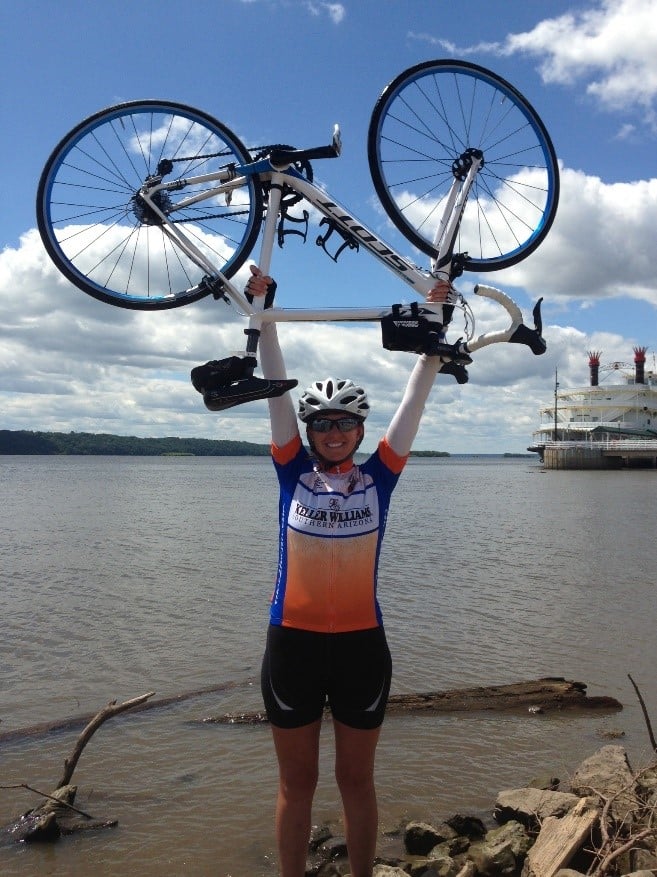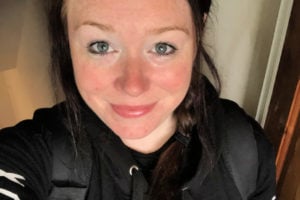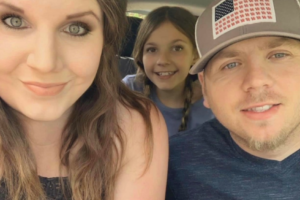I was the most fit I had ever been when I had my deep vein thrombosis (DVT) and pulmonary emboli (PE) at 28 years old. I ran marathons, competed in triathlons, and had just recently completed my first 100-mile bike race. After my bike race, I was struggling to recover. My legs felt heavy. My heart was racing. My lungs felt sore. I had pains in my abdomen and lower back. I was also finishing my first semester of graduate school and did not have health insurance. I attributed all of my symptoms to sports injuries and anxiety. I delayed seeking care. I never suspected blood clots since I was unaware of my risk factors.
When my left leg doubled in size and turned purple, I waddled into an emergency department and was hospitalized for six days. This was three weeks after the bike ride, which is believed to be the catalyst of my clotting. I had emergency surgery to remove the clot that extended from my abdomen to my left knee (deep vein thrombosis). I had clots in both lobes of my lungs (pulmonary emboli).
Many diagnostic tests later, the perfect storm causing my extensive clotting was discovered:
- I have a prothrombin gene mutation (factor II), which causes me to have an excess of clotting proteins in my blood plasma.
- I have a compression of my left iliac vein, an anatomical abnormality in which one of the arteries in the abdomen crosses over and compresses the vein against the spine. This is called May-Thurner Syndrome (MTS). The compression of my vein caused a complete closure of the vein, stopping all blood flow from the lower left side of the body.
- Unaware of these other two risk factors, I was taking estrogen-based birth control that further multiplied my clotting risks.
- Finally, the seven hours I spent on my bike, and the micro-injuries and dehydration induced by the endurance exercise, served as a catalyst for the clotting in this perfect storm.
I was lucky to survive with no permanent damage from the extensive clot and delayed care. I credit this to my cardiovascular fitness at the time and a vascular surgeon who put the pieces together and treated my case aggressively. I had an intensive, yet non-invasive surgery within a day of entering the hospital to remove my clots, place a stent in my left iliac vein, catheters to remove the excess fluid, and a filter below my heart to prevent more PEs during my recovery. A hematologist prescribed me a year of warfarin, which I combined with gradual moderate-to-vigorous physical activity.
At my six-month check-up, my vascular surgeon and hematologist agreed that I was fully recovered and could stop taking warfarin. This was a shared decision based on my thorough understanding of my risk factors and demonstrated ability to reduce my risk factors. Since I had controlled all my other clotting risk factors, the risk of taking warfarin as a cyclist (with the potential of bike accidents that could cause life-threatening hemorrhage) outweighed the clotting risk of my prothrombin gene mutation.
It’s been eight years and I remain clot-free without anticoagulant medication. I have annual sonograms done of my stent and veins to ensure clear pathways. I am careful to avoid all additional risk factors for clotting, including estrogen hormones, prolonged sedentary activity, smoking, and excess weight.
I aim to increase my protective factors as much as possible and have worked with my doctors to come up with a plan that works for me, such as taking aspirin and staying hydrated, scheduling shorter flights with more layovers and walking during layovers, being physically active every day, using stand-up desks and taking frequent short walk breaks throughout the day at work.
Learning about my risk factors has been essential to recovering from this trauma and reducing my anxiety and risk for future clots. The information about prothrombin gene mutation, May-Thurner Syndrome, and risk factors for athletes on the National Blood Clot Alliance’s website gave me a place to start and pointed me in the right direction for learning more. This allowed me to negotiate with my medical team for a long-term treatment and monitoring solution that provides me the quality of life I desire.
Resources
- Join our online peer support community to connect with other people who have experienced a blood clot.
- More about blood clot treatment and recovery.
- Read more stories, or share your story with NBCA.




